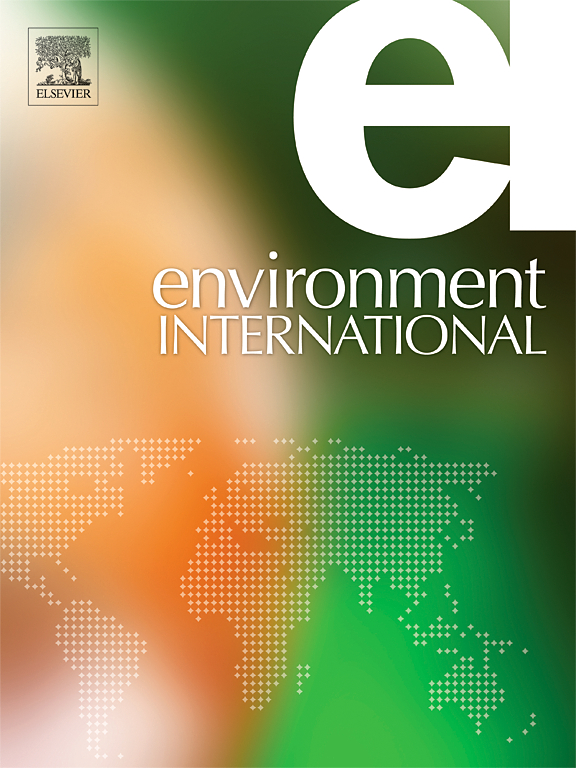在西澳大利亚州,产前和儿童早期暴露于生物热应激和入学时的发育脆弱性:一项基于人群的队列研究
IF 10.3
1区 环境科学与生态学
Q1 ENVIRONMENTAL SCIENCES
引用次数: 0
摘要
全球气温上升,包括在澳大利亚,增加了生物温热压力。然而,通过通用热气候指数(UTCI)测量,产前和儿童期暴露于极端双温应激对儿童早期发育脆弱性的影响尚不清楚。本研究旨在研究西澳大利亚产前和幼儿暴露于生物热应激与幼儿入学时发育脆弱性之间的关系。方法对2009-2015年澳大利亚早期发展普查(AEDC)的59,771名儿童进行基于人群的回顾性队列研究。UTCI在时空上与统计区1 (SA1)水平的产妇出生时的居住地址相关联。计算每个孩子从受孕到AEDC评估的平均UTCI暴露,并对产前(受孕至出生)和产后(出生至AEDC评估)暴露进行单独分析。采用混合效应logistic回归模型检验儿童发育脆弱性与生物热应激之间的关系。结果从受孕到AEDC评估的平均UTCI暴露为14.4 + 2.5 °C。在调整了潜在的混杂因素后,在此期间暴露于热应激的儿童患DV1的几率(在一个或多个AEDC结构域上发育脆弱的儿童的百分比)比暴露于最佳热条件(9-26 °C)的儿童高29 % (or: 1.29;95 % ci: 1.05-1.58)。产前暴露于热应激与DV1的几率增加34% %相关(OR: 1.34;95 % ci: 1.10-1.65)。结论从受孕至AEDC评估日期间暴露于热应激环境会增加发育脆弱性,且在产前期间影响最明显。决策者可以将热暴露考虑纳入孕产妇和儿童健康战略,以减轻弱势群体的风险。本文章由计算机程序翻译,如有差异,请以英文原文为准。


Prenatal and early childhood exposure to biothermal stress and developmental vulnerability at school entry in Western Australia: a population-based cohort study
Backgrounds
Rising global temperatures, including in Australia, increase biothermal stress. However, the impact of prenatal and childhood exposure to extreme biothermal stress, measured by the Universal Thermal Climate Index (UTCI), on early childhood developmental vulnerability remains unclear. This study aimed to examine the association between prenatal and early childhood exposure to biothermal stress and early childhood developmental vulnerability at school entry in Western Australia.
Methods
A population-based retrospective cohort study of 59,771 children from the 2009–2015 Australian Early Development Census (AEDC) was conducted. UTCI was spatiotemporally linked to maternal residential addresses at the time of birth at the Statistical Area 1 (SA1) level. The average UTCI exposure from conception to AEDC assessment was calculated for each child, with separate analyses for prenatal (conception to birth) and postnatal (birth to AEDC assessment) exposure. Mixed-effect logistic regression models were used to examine the association between childhood developmental vulnerability and biothermal stress.
Result
The mean UTCI exposure from conception to AEDC assessment was 14.4 ± 2.5 °C. After adjusting for potential confounders, children exposed to heat stress during this period had 29 % higher odds of DV1 (developmentally vulnerable in one or more AEDC domain(s)) than those exposed to optimal thermal conditions (9–26 °C) (OR: 1.29; 95 % CI: 1.05–1.58). Prenatal exposure to heat stress was associated with 34 % higher odds of DV1 (OR: 1.34; 95 % CI: 1.10–1.65).
Conclusion
Exposure to heat stress from conception to the AEDC assessment date increases developmental vulnerability, with the strongest effect observed during the prenatal period. Policymakers might integrate heat exposure considerations into maternal and child health strategies to mitigate risks for vulnerable populations.
求助全文
通过发布文献求助,成功后即可免费获取论文全文。
去求助
来源期刊

Environment International
环境科学-环境科学
CiteScore
21.90
自引率
3.40%
发文量
734
审稿时长
2.8 months
期刊介绍:
Environmental Health publishes manuscripts focusing on critical aspects of environmental and occupational medicine, including studies in toxicology and epidemiology, to illuminate the human health implications of exposure to environmental hazards. The journal adopts an open-access model and practices open peer review.
It caters to scientists and practitioners across all environmental science domains, directly or indirectly impacting human health and well-being. With a commitment to enhancing the prevention of environmentally-related health risks, Environmental Health serves as a public health journal for the community and scientists engaged in matters of public health significance concerning the environment.
 求助内容:
求助内容: 应助结果提醒方式:
应助结果提醒方式:


